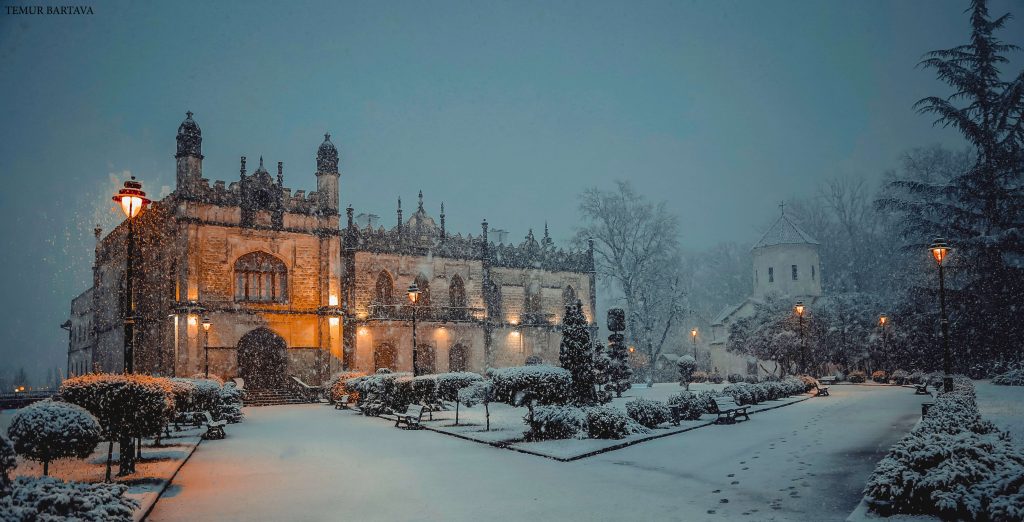Dadiani Palaces-Historical-Architectural Museum

In the 1850s, Chief Davit Dadiani established a museum in the palace that held the Dadiani collection of fine and ethnic art and the special numismatic material found as a result of the archaeological investigations of the ancient city of Archeopolis (Nokalakevi). Currently, the museum is home to 44,475 objects, including: an axe from the first century; examples of 19th-century goldsmithing (icons and other items of church purpose, works of fine art), archaeological artifacts that portray the cultures of ancient Greece and Colchis, a collection of Christian relics, and European decorative arts (in the styles of the Bulle, Rococo, and Empire);
The leaders of Samegrelo moved into Zugdidi during the rule of Levan II Dadian, as is recorded from historical records. Christopher Castel, Arcangelo Lambert, and Chardin provide us with information about this. Zugdidi was obviously a well inhabited area, as stated by Vakhushti Batonishvili: “Zugdidi is at the summit of the Great Velsa, the palaces of the Dadians, Didshen and Palatebiani, Gherke-Godoliani.” the princely temple and the ornamental garden close to the palace). Prior to being transformed into the Queen’s Palace by the German architect Rice in the 1960s of the 19th century, Pup, the sister of Prince David of Samegrelo, lived there. Rice created large wings and built the second floor’s arches. The palace has a balcony with a distinctive wooden ceiling.
The Russian architect Leonid Vasiliev constructed the Nikos palace in the eighties of the nineteenth century.
The two-story house has Georgia’s largest ballroom and is embellished with a stone balcony.
The museum was established in April 1921 using the antiquities from Samegrelo’s churches and monasteries as well as the treasure trove of Dadiani, the prince of Samegrelo Davit Levani.
In its funds are kept some 50,000 exhibits, examples of both national (dating from the Bronze Age to the Dadian memorial artifacts at the end of the 19th century) and European cultural heritage.
The ancient and new stone age implements are noteworthy among the archaeological monuments.
In the Zugdidi district and the area around it, several bronze axes have been discovered.
On the right bank of the Enguri settlement, there is a casting mold for the Kolkhir ax that merits special consideration. around Tagilon
A significant number of copper ingots have been discovered, attesting to the regional manufacture of bronze tools, notably axes.
The activities of the older population of Kolkheti can be clearly seen in the settlement of Zugdidi district in 1935–1936.
Material-cultural artifacts discovered at the excavation of the dikha-gudzube near Anaklia.
The Holy Mother of God’s robe, which was transferred to Georgia in 1453 following the fall of the Byzantine Empire, is the most important Christian relic and the treasure of the Zugdidi Museum. Prior to being told to go to the Khobi church, he was told to go to the Bedi temple. Levan I Dadian has been taking a nap in the royal palace since 1533.
The holy relics are kept in a little silver-plated luskuma that has a gold relief image of the Virgin Mary and is embellished with precious stones.

The Samegrelo Chief Levan II Dadian (1611–1657) and Queen Nestan–Darejani are mentioned in the equestrian inscription from Luskum. The XVI-XIX centuries are preserved in the museum’s manuscript collection. Deed-gujres, miniatures, and volumes with distinctive handwriting. It is important to highlight the literary archive, where works from the XIX and XX centuries have been preserved. Famous Georgians including Grigol Orbeliani, Platon Yoseliani, Iona Meunargia, Niko Nikoladze, Tedo Jordania, and others corresponded with one another.
The bronze mask of Napoleon I (1769–1821), which was cast by anatomy professor Francesco Antomarco (1780–1838) in Paris in 1833, is one of the museum’s unique items. The name of the plaster mask manufacturer, “Doctor F. Antomark,” is written on the mask’s neck.
The museum’s treasures are the creations of Georgian, Russian, and international artists. The first Georgian chess player was Dadiani, the son of Andria David. In the chess community, he was well-known. Andria presided over the Monte-Carlo International Chess Tournament between 1900 and 1904. Under his direction, a number of rewards (for lovely parties) were introduced.
Among these, the German painter Franz Xaver Winterhalter’s portrait of Ekaterine Chavchavadze is noteworthy. Around 1865, the portrait was created in Paris. Catherine originally resided in Russia after the Principality of Samegrelo was abolished (1857), and then she moved to Europe. The queen received the bronze medal depicting St. George for his contributions to the Russo-Turkish War of 1853–1855, where he personally oversaw the Samegrelo Principality’s army in one engagement. On the day of Emperor Alexander II’s coronation in 1856, the queen received the St. Catherine the Great Cross.
The Dadian family collection has a portrait of Niko Dadiani (1847–1903), the final prince of Samegrelo, created by an unidentified artist.
The weapon that he and his brother Andria Dadiani received for their gallantry during the Balkan campaign is seen here. Niko gave the town the special Dadians library as a gift, fostering reading among Georgians. He built numerous humanitarian organizations, schools, homes for the vulnerable, and pharmacies in Georgia.
Several dozen pieces by French artist Pierre Blanchard that were presented to Niko Dadian by the Russian Emperor Alexander II, the queen of Samegrelo, and other members of the Dadian family in St. Petersburg, on the day of Alexander II’s coronation, are still kept in the Dadian Palace. Blanchard produced a vast array of works while he was in the Caucasus, including “Dagestan,” “Kakheti,” “Tiflis,” “Freedom in Georgian,” etc.





Leave a Reply
You must be logged in to post a comment.